

Bishop handicap differs from the larger ones in that black is not advised to pursue a strategy different from one that he might adopt in an even game. Rather, he should choose between static rook and fortress (Yagura) castle, or ranging rook and Mino castle, just as he might do in an even game. Bishop handicap is more difficult for black than one might expect, because in the starting position the rook bears down directly on the bishop, and so the bishop can be a target. This often means that white will be the one to start the attack, rather than black as is usual in other handicaps. So bishop handicap is said to teach defensive skills along with attacking skills, and so is more akin to an even game. It is also thought to emphasize endgame skills, as white can usually make the ending close.
There is great disagreement among pros as to how wide is the gap between bishop and rook handicap. Some say that it is huge, while others say that the two handicaps are quite close. Having played over a hundred handicap games with pros at bishop or rook handicap (perhaps 3/4 at bishop), my view is that the gap is the smallest in the handicap series but is still substantial.
In the 1800s black usually played third file rook and Mino castle. This strategy prevents white from launching any effective attack, as the black king is removed from the danger area and the black rook guards the most vulnerable file, the one where the bishop must go after ... P8e. Black has plenty of time to complete his castle and make everything safe. White often ends up just "passing" (moving a gold back and forth for example). However, it is quite difficult for black to start the fight, and if he wishes to avoid Sennichite (draw by repetition), as he is generally expected to do, he must often resort to risky plans.
Around 1900 it became popular for black to play static rook and fortress castle, and this is generally considered the main line even today. If white starts out with ... P8d and ... P8e this strategy is particularly appropriate, because the silver on 7g (the key move of the fortress opening) prevents a pawn exchange. However today white usually refrains from ... P8e in the early stages, and then if black still plays the fortress the silver on 7g is a potential target for a N8e attack. Although this is joseki, the variations involving this N8e attack are pretty complex and tricky, and so I don't recommend the fortress strategy except against a very quick ... P8e (which can also be well met by playing opposing rook). Also, the fortress lines tend to be rather easy for white to play.
In modern times, perhaps forty years ago or so, central rook and Mino became popular for black. The idea is to advance and/or exchange off the center pawn, and then bring up the left silver to the 5f square. This is very good shape (silver in front of rook with no pawn behind the silver, and nothing blocking the bishop), and is considerably more aggressive than third file rook. This strategy is one of my favorites. One argument against it is that if white refrains from advancing his rook's pawn, he may later switch his rook to his left and castle right, in which case black will have no direct pressure on the front of the castle (as he would with 3rd file rook, for example). If white adopts this strategy black should switch from Mino to a right fortress castle, to prevent white from exchanging off the 2 pawn. The game then resembles a normal fortress opening, but with everything on the wrong side of the board!
In the last two decades, black has often chosen fourth file rook, the strategy that has become the dominant form of ranging rook in even games. I think that it is particularly appropriate at bishop handicap, because the rook supports the natural move P6e which will reopen the bishop's diagonal. In even games this risks a bishop exchange, which is often undesirable for the ranging rook side, but here there is no downside to the move. Pros seem to be pretty evenly split on the question of whether central or fourth file rook is the best ranging rook for bishop handicap. I have played both many times, and my feeling is that I have done a bit better with fourth file rook, though it's not quite clear. I have chosen to recommend fourth file rook in this article, primarily because it is more of a deterrent to the white plan of castling right, since the spearhead of black's play will be one file closer to the white king in that case. Another plus is that castling is easier with fourth file rook, since a central rook interferes with the natural G(6i)-5h-4g. The following analysis is based heavily on a "Shogi Sekai" supplement by Izumi 7 Dan and on a book by Manabe 8 Dan ("handicap revolution"). There are two main lines, depending on whether or not white allows black a vanguard pawn on 6e.
Line 1 Vanguard allowed
Line 2 Vanguard prevented
The following bishop handicap I played with professional player Makoto Chuza, 5 Dan illustrates the system I recommend rather well. This game followed line 2 of this article, the initial (main) line, but white omitted 6... G6c.
[Sente "Larry Kaufman, amateur 5 Dan"]
[Gote "Makoto Chuza, 5 Dan"]
[Date "2002/10/19"]
[Site "Second International Shogi Forum, Tokyo"]
[Handicap "Bishop"]
[Result "1/2"]
1... S6b 2.P7f P5d 3.P6f P6d 4.R6h S5c 5.P9f R6b 6.B9g G4a5b 7.N7g K4a 8.S7h K3b 9.P6e
(9.K4h { then K3h first is also plausible, but I was concerned that after 9... S3a4b
the game continuation would not work as 5c is too well defended }) Px6e 10.Nx6e S6d

After 10... S6d
11.Bx6d Rx6d 12.S*5c Gx5c 13.Nx5c+ S*6f 14.G45h B*4d
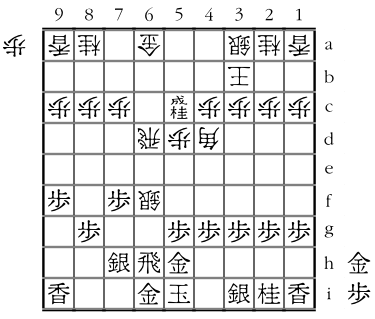
After 14... B*4d
15.+Nx5d Rx5d 16.G*4e P*6g 17.Sx6g Sx5g+ 18.Gx5d +Sx6h 19.G6ix6h Bx9i+ 20.R*8b N*6b 21.Rx8a+ Nx5d 22.+Rx6a P3d 23.+R5b G*4b 24.+Rx5d L*5b 25.+Rx3d P*3c 26.+R2e Lx5h+ 27.Sx5h { I've traded my bishop for silver, knight, and two pawns, and with so many pieces in hand I am clearly winning } R*8i 28.P*6i G*7g
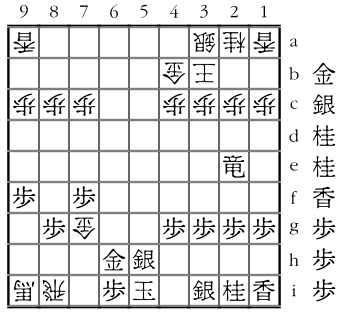
After 28... G*7g
Here I erred by attacking with 29.L*2f, which gave him a strong attack by 29... Gx6h 30.Kx6h Rx8g+ the game ending a few moves later in a draw by repetition (Sennichite). Instead, 29.Gx7g +Bx7g 30.G*6h leaves me with an easy win, as Mr. Chuza pointed out after the game.
Hirotaka {"Tiger"} Nozuki Pro 5 Dan played the game with me in Chicago on the 26 April 2003 and reviewed it afterwards before the audience at the U.S. Championship. The following comments are based heavily on his.
1... S6b 2.P7f P5d 3.P6f P6d {it seems that most pros prefer not to allow the vanguard pawn} 4.R6h S6c {as I recommend in this article} 5.S7h S4b 6.K4h S5c 7.S3h P7d {deviating from the normal 7... K4b given in this article} 8.K3i P8d 9.P6e Px6e 10.Rx6e K6b {right side king, which is more aggressive than the usual left side king. But it is precisely because of this possibility that I prefer fourth file rook over central rook, as my attack will be closer to his king.} 11.R6h P*6d 12.S6g P4d 13.G65h G3b 14.S6f {14.P4f and S5f was the plan given in my article against left side king. But against right side king, S6f seemed better to me.} P3d 15.K2h N3c 16.P1f P1d 17.P5f G4c 18.P9f P8e 19.B9g !
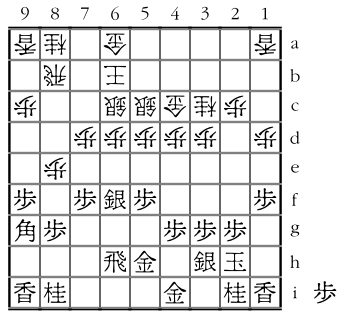
After 19.B9g !
{Perhaps white would have played P8e before I played P9f if he knew I intended this move. I say in this article not to play this way against the silvers on 6c and 5c, but I felt that the location of white's king justified the plan here.} G7b 20.N7g P9d 21.P*6e P8f (Px6e 22.Sx6e P*6d 23.Sx6d {and although I lose bishop for silver and pawn, the lack of any pawn to drop in defense should prove fatal to white}) 22.Bx8f {even better was taking on 6d first} Px6e 23.P*6d !

After 23.P*6d !
S6cx6d (Px6f 24.Px6c+ Gx6c 25.Rx6f P*6d 26.P*6e Px6e 27.Nx6e S6d 28.Bx6d Gx6d 29.S*5c Gx5c 30.S*7a Kx7a 31.Nx5c+ P*6e 32.P*6c Rx8g+ 33.R6g {with decisive advantage. I wonder if I could have found all these moves had he played this way. I felt during the game that Nozuki always chose the "correct" move rather than the trickiest one.}) 24.Nx6e P*6c 25.Nx5c+ Sx5c 26.P5e Px5e
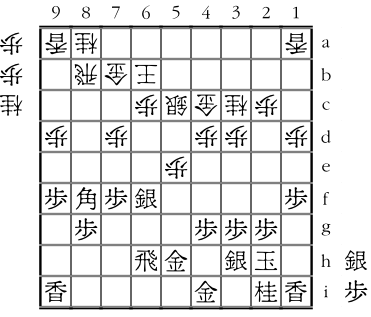
After 26... Px5e
27.S6e ({Even better was} 27.Sx5e P*5d 28.P*6d Px5e 29.Px6c+ Gx6c 30.S*7a Kx7a 31.Rx6c+ S*6b 32.+R5b G4b 33.G*6a {winning. Of course if I could see all this in 1 minute, being in byoyomi by now, I wouldn't need a handicap from anyone !}) N*6d ! 28.S*3b G5d 29.S4c+ Gx6e 30.Rx6e S*5d 31.G*5b ! K7c 32.R6f Sx4c 33.Gx5c S*8e 34.B5i {Nozuki expected me to trade the bishop for knight and silver, but my move is also good} S3b 35.P*6e Nx7f 36.P8f Sx8f 37.Rx7f S7e 38.Rx7e !

After 38.Rx7e !
Px7e 39.N*8f G8c (K8d 40.S*7d P*8e 41.Gx6c Gx6c 42.Sx6c= Px8f 43.P*8e Kx8e 44.S*7d K8d 45.G*8e K9c 46.P9e {winning}) 40.S*8e N9c 41.S*7d Gx7d 42.Sx7d K8d 43.Gx6c P7f 44.B4h {white almost got an entering king, but fortunately "almost" doesn't count !} P*6f 45.Bx6f S*7e 46.P*8e !
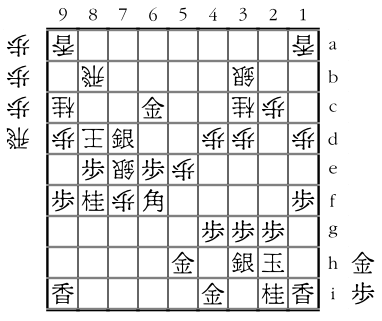
After 46.P*8e !
Nx8e 47.S7c= {and white resigned. Despite my inaccurate moves 22 and 27, this was a nice example of the B9g attack}
Bishop Handicap Summary :